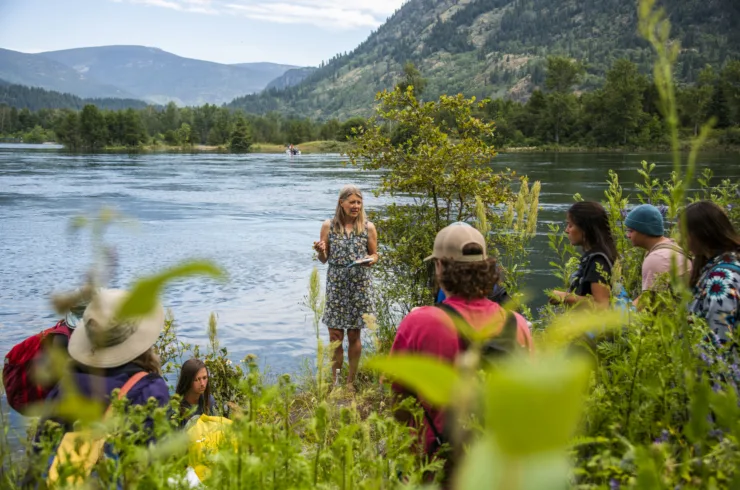When you first set eyes on Kimberley artist Sam Millard’s vibrant painting of the Elk Valley, it looks to be one of joy. A technicolour elk bays at the rising sun, a moose wanders through the Elk River, and in the distance, a bear meanders across a mountainside that’s teeming with life.
But look more closely at the scene and you’ll realize there’s more to it than initially meets the eye.
“The story of this painting is a powerful one and documents the here and now,” says Sam, who was commissioned to create the piece. “It’s about the Elk Valley, capturing the relationship of wildlife to the land, and the impact the coal mines have on their habitat.”
In the upper right corner of Sam’s painting, colourful geometric shapes fade to grey on the slopes of a mountain that sits beneath a foreboding sky. In the valley below, a bighorn sheep, mountain goat and grizzly bear have their gazes turned toward the scene, as if on alert to a potential threat.


Sam says the grayscale mountain represents “the next target on the chopping block to be decimated in the name of coal mining”: Castle Mountain.
Located north of Elkford, on the eastern side of the Elk River, Castle Mountain sits adjacent to Glencore’s (formerly Teck’s) Fording River coal mine. Its rare, high-elevation grasslands provide important grazing habitat for local bighorn sheep, and comprise a huge portion of their winter range. But those grasslands are now under threat thanks to the coal strata that lie beneath them.
The proposal to mine Castle Mountain first came about in 2018. Back then, the project was called the Castle Mountain Expansion and was met with widespread opposition from First Nations and environmental groups alike. Teck later renamed the project the Fording River Extension (FRX). Despite the name change, the proposal remains, for all intents and purposes, a brand new mine in a valley who’s wildlife populations and aquatic ecosystems are already suffering from the impacts of five other massive metallurgical coal mines.
In order to accurately portray the animals, habitats and local features of the Elk Valley, Sam spent a lot of time researching and sketching before putting brush to canvas. During her planning, she was shocked to see the visual toll that mining has taken on the region. “One of the biggest eye openers in my research was using Google Earth’s historical imagery of the Elk Valley to really see how much the landscape there has changed over the years. It’s quite astonishing,” she says.


While coal mines have operated in the Elk Valley for over 120 years, it was the shift towards large-scale, open-pit mines in the mid-20th century that really began to change the face of the landscape. More than 16,750 hectares of habitat have now been disturbed due to Elk Valley mining operations. In some cases, the industry has quite literally brought down whole mountains — and filled in entire valleys with the leftover rock.
With a footprint of about 5,390 hectares, Fording River is not only the largest mine in the Elk Valley, but in all of British Columbia too. The Fording River Extension would approximately double its size, increasing the mine’s footprint by 2,330 hectares outside of its currently permitted operating area, and 2,320 hectares within the current operating area. This would prolong Fording River’s lifetime by several decades (the mine’s current supply of economically usable coal is set to run out by the early 2030s).

Given the enormous footprint of the project, it’s unsurprising there’s widespread concern it would come at a hefty cost to wildlife. The amount of available fish spawning habitat in the Upper Fording River and downstream would be drastically reduced. Grizzly bears, black bears, elk and numerous other animals would be displaced. But one species in particular would feel the impacts more than others: bighorn sheep.
Wildlife biologists agree that the large-scale destruction of Castle Mountain’s rare high-elevation grasslands would very likely result in a bighorn sheep population decline. The high-quality, accessible forage that these grasslands provide sheep during winter is essential to their survival. Their loss would force sheep into adjacent grasslands some of which are already overgrazed.


While Glencore claims it would restore the grasslands once mining is complete, the BC Centre for Conservation Data says it has never observed successful recovery or remediation of this ecosystem — the unique combination of soil composition, winds, aspect and species diversity is too difficult to replicate.
The more you learn about the Elk Valley mines, the deeper the sense of dread becomes. How can a landscape hope to recover from these devastating impacts? But Sam’s artwork stands as a beacon of hope in the face of such thinking — it’s colourful and still full of life, in spite of the havoc that’s been wrought.
“Nature knows best and often finds a way to persist, so I’m optimistic!” she says. “I love that this piece sparks conversation that allows individuals to form their own perceptions of the current era.”
Update: The revised details of Glencore’s Fording River Extension were released in early July 2025. Due to the impacts this mine would have on terrestrial and aquatic ecosystems, Wildsight is strongly advocating for a public comment period. This will be an important opportunity to have a say in the future of the Elk Valley’s bighorn sheep.
To see more of Sam Millard’s artwork, visit her website and her Instagram.








